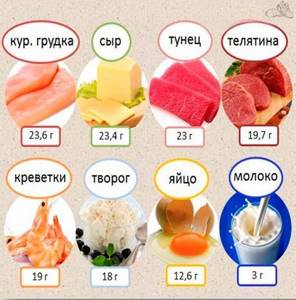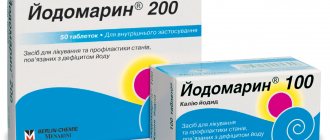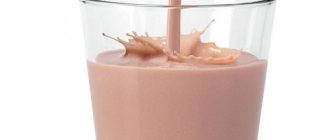The importance and norms of protein content in human nutrition[edit | edit code]
Yuzhakov Anton Protein (protein). Everything you need to know about protein. Norms per day, speed of absorption, speed of digestion, best sources of protein, complete and incomplete protein
Yuzhakov Anton The best protein products: Meat, Fish, Dairy products, Eggs, soy and nuts
Protein is one of the vital nutrients. The sufficiency of its content in the diet and high quality make it possible to create optimal conditions of the internal environment for the normal functioning of the body, its development and high performance. Protein is the main component of the diet, determining the nature of the entire diet. Against the background of a high level of protein, the most complete manifestation of the biological properties of other nutritional components in the body is noted.
For children, adolescents, young men and women, a high level of protein in the diet becomes especially important, since normal growth and development of the body proceeds most effectively with sufficient (quantitatively and qualitatively) protein nutrition. When the body’s growth is completed, food protein becomes a source of restoration and renewal of cells and tissues (protein makes up 45% of the body’s dry residue).
Protein is an integral part of the protoplasm of cells, in which a continuous process of protein breakdown occurs and at the same time its synthesis from food protein, as well as an important component of cell nuclei and intercellular substances. Of particular importance are specific proteins that are part of enzymes, hormones, antibodies and other formations that perform a very complex and subtle function in the body. These proteins include: globin, which is part of hemoglobin, red blood cells and performs the most important function of respiration, supplying tissues with oxygen; myosin and actin, which provide muscle contractions; globulins, which form antibodies that protect against infection; a protein that forms visual purple (rhodopsin) of the retina and ensures normal perception of light, etc.
Protein is of great importance for higher nervous activity. Its normal content in food improves the regulatory function of the cerebral cortex, increases the tone of the nervous system, accelerates the development of conditioned reflexes; With a lack of protein, these processes are weakened.
Proteins are used in the body mainly as plastic materials. Along with this, they participate in the body’s energy balance - especially during periods of energy expenditure or when there is insufficient carbohydrate and fat content in food.
A systematic lack of protein in the diet affects the general condition of the body and its development, as well as the formation of the characteristics of a person’s physical status. Thus, the population of the swampy lowlands of North-Eastern Brazil, who for centuries suffered from a lack of protein, developed very significant impairments in physical condition and development - for example, short stature (15-year-old boys look like 8-year-old children).
Under the influence of protein deficiency, nutritional dystrophy, marasmus and kwashiorkor occur. Nutritional dystrophy and marasmus are diseases of general malnutrition; in their etiology, the main role is played by protein-calorie deficiency, general hunger, accompanied by insufficient intake of proteins, fats, carbohydrates, etc.
Kwashiorkor is a disease of pure protein deficiency, widespread in many countries among socially oppressed sections of the population (especially in colonial-dependent, underdeveloped countries). Recent international data shows that kwashiorkor is one of the most common diseases worldwide. The name of the disease itself means “weaned (from the breast) child”; it is characteristic of children under 5 years of age (mainly up to 3-4 years of age), whose diet is dominated by carbohydrates and has an extremely insufficient amount of animal protein. Kwashiorkor is characterized by a slowdown in the growth and development of the child, changes in skin color and condition of the mucous membranes, deterioration in the functions of all systems (especially the digestive system - diarrhea), edema, mental retardation, and apathy.
In addition, with a lack of protein, the functions of the endocrine glands are affected, the formation of hormones is disrupted, and the reactivity and resistance of the body to infections and intoxications decreases. When the protein content in food decreases, bone growth stops and their structure changes; the amount of calcium decreases and the amount of magnesium increases; The release of calcium from the body increases and the release of phosphorus decreases.
During the digestion process, proteins break down into amino acids, which are the main components and structural elements of the protein molecule. In various combinations they form proteins of varying composition and properties. The nutritional value of proteins is determined by the quality and quantitative ratio of the amino acids that form them.
Arriving after the breakdown of proteins from the intestines into the blood and further into the tissues, amino acids are used for the synthesis of living protein, strictly specific to a given organism.
There are 22 amino acids most common in foods, although more than 80 amino acids are now known.
It is generally accepted to divide amino acids into essential and non-essential. Nonessential amino acids can be synthesized in the body and thus supplement the supply of these amino acids from food. Essential amino acids cannot be synthesized in the body and must be supplied as part of food proteins. These amino acids are of particular value and are used for the synthesis and formation in the body of specific proteins, secretions, hormones and other biologically highly active components.
The 8 essential amino acids are: tryptophan, lysine, leucine, isoleucine, methionine, phenylalanine, threonine and valine. A number of scientists classify 4 more amino acids as essential: arginine, histidine, tyrosine, cystine.
Plant proteins, unlike animal proteins, are often less valuable - due to the insufficient content or absence of some essential amino acids in them.
Considering that there is already a shortage of animal proteins in the world, humanity is taking measures to develop industrial methods for their production from plants and inorganic substances.
An adult under normal living conditions requires an average of 1.3-1.4 g of protein per 1 kg of body weight per day, and during physical work - 1.5 g or more. This amounts to 96-132 g per day for men and 82-92 g for women.
Athletes require an average of 2.0-2.5 g per 1 kg of body weight per day. In gymnastics (sports and rhythmic), acrobatics, fencing, long-distance running, swimming, rowing, sports games - 2.0-2.3 g; in throwing, short and marathon running, jumping, weightlifting, boxing and wrestling - 2.3-2.5 g; in multi-day cycling races, the need for proteins increases to 3.0-3.2 g per 1 kg of body weight.
Children, unlike adults, aged 7-12 years need 2.5-3.0 g of protein per day per 1 kg of body weight, at the age of 12-16 years - 2 g. When examining students at a sports boarding school, it was found that that children 11-13 years old need to consume 3 g of protein per 1 kg of body weight per day, and adolescents 14-17 years old - 2-2.5 g.
To ensure a normal amino acid composition, it is necessary that in adults at least 50% of proteins are of animal origin, in children - at least 60%. For adult athletes, the proportion of animal proteins should be at least 60%; for young people - 70% (while 40% of animal proteins should come from meat, fish, eggs and 30% from milk and dairy products).
As already mentioned, the most complete proteins of animal origin are the proteins of chicken eggs, meat, and fish; in second place are the proteins of dairy products.
Among plant proteins, soybean proteins have high biological value; somewhat smaller - proteins from beans, potatoes, rice. Incomplete proteins are found in peas, bread, corn and some other plant foods.
At the same time, in food rations such combinations of products of animal and plant origin can be selected in which the deficiency in amino acids of some products is covered by others. For example, buckwheat porridge, whose proteins are characterized by insufficient lysine and an excess of cystine and arginine, is advisable to consume with milk, the proteins of which contain a lot of lysine and little arginine and cystine.
Beneficial combinations of amino acids are obtained by consuming milk with white bread and flour products with cottage cheese and meat (dumplings, dumplings, pies, sochniki, etc.).
The main sources of protein in the diet are meat and meat products (sausage, frankfurters, ham, etc.), fish, eggs, dairy products (cheese, milk, cottage cheese, feta cheese, etc.), fish caviar, beans, cereals, flour products.
The insufficient nutritional value of most plant proteins refutes the scientific basis of the doctrine of vegetarianism, which involves the consumption of exclusively plant foods. Vegetarianism is worse for athletes also due to the large volume of food and its poorer digestibility (especially proteins).
Consumption of protein in excess of the given norms is harmful to the body, as it can disrupt the normal state of the cerebral cortex (excessive excitability), liver and kidney functions; cause an overload of the body with decay products and incomplete oxidation of proteins, which, under the influence of putrefactive bacteria in the intestines, can decompose with the release of toxic substances (indole, skatole, phenol, paracresol, etc.).
Protein sources
Before answering the question of how much protein a person should consume per day, let's look at what types of protein there are. This nutrient comes in animal and plant origin and is found in foods.
| Animal proteins | Plant proteins |
| Meat, fish, poultry, seafood, milk and dairy products, eggs | Beans, seeds, nuts, cereals, vegetables, fruits, berries |
Daily protein intake in an athlete's diet[edit | edit code]
Protein needs of athletes
has always been a subject of debate.[1][2][3][4][5] Initially, it was believed that protein intake should not exceed the recommended daily value (0.8-1.0 g/kg/day for children, adolescents and adults).
However, research conducted over the past 10 years has shown that athletes who train intensely have higher protein intake (1.5-2.0 g/kg/day) to maintain nitrogen balance.[1][2 ][4][6][7] If the diet does not include enough protein, the athlete’s body develops a negative nitrogen balance, which leads to increased catabolism and slow recovery after training. Over time, this leads to loss of muscle mass and decreased endurance during training. [1,8].[8][9]
For people who are engaged in a general fitness program, the protein norm is 0.8-1.0 g/kg/day of protein. For older adults, the protein intake is approximately 1.0-1.2 g/kg/day, which will help prevent sarcopenia.
For athletes with moderate intensity training, it is recommended to consume 1-1.5 g/kg/day of protein (50-225 g/day for athletes weighing 50-150 kg), while for high-intensity training, it is advisable to consume 1.5- 2.0 g/kg/day protein (75-300 g/day for athletes weighing 50-150 kg).[10]
This protein requirement is equivalent to 3-11 servings of chicken or fish per day for an athlete weighing 50-150 kg.[10]
Athletes with a small mass are able to obtain this amount of protein through regular food, while for athletes with a large mass this can be physically difficult.
In addition, in certain sports, a lack of protein in the diet occurs more often (runners, cyclists, swimmers, triathletes, gymnasts, dancers, speed skaters, wrestlers, boxers, etc. are susceptible to this). These athletes should be more careful about the protein content of their training diet to maintain nitrogen balance (1.5-2 g/kg/day protein).
It should be noted that there are different types of proteins with different properties. Proteins differ in origin, amino acid composition and method of processing (isolation).[11]
These differences affect the availability of amino acids and peptides that have biological activity (for example, α-lactalbumin, β-lactoglobulin, glycomacropeptides, immunoglobulins, lactoperoxidases, lactoferrin, etc.). In addition, differences are evident in the rate of digestion and absorption, as well as metabolic activity.[11] Different types of proteins (such as casein and whey protein) are digested at different rates, which directly affects the body's overall catabolism and anabolism.[11][12][13][14] Therefore, it is important to pay attention not only to the quantity, but also to the quality of the protein included in the athlete’s diet.
The best sources of high-quality, low-fat protein include skinless chicken, fish, egg whites, and cottage cheese (casein and whey).[11] Supplements include whey protein, colostrum, casein, milk protein, and egg protein.[10][11]
Some athletes do not need sports supplements, getting enough protein from food. However, including protein supplements in the diet, as well as consuming amino acids in ready-made form after training, is a very common practice. It allows you to optimize the nitrogen balance in the athlete’s body.
How much protein does a person need per day for muscle growth (men)?
There is fierce debate about this among strength training enthusiasts. Different numbers are given: from 1.5 to 4 g per 1 kg of weight. There is a middle ground promoted by most sports clubs. This number is 2. If someone is unable to build muscle with this amount of protein, then perhaps there are errors in nutrition:
- Single servings are too large. It is better to split your protein intake into small portions and eat no more than 30 g at a time.
- Plant proteins instead of animal proteins. We have already written that the entire set of amino acids is contained in proteins of animal origin. Plus, such nutrients are better absorbed by the body, which means they work.
- Lack of carbohydrates. For better absorption of proteins, you should eat them with carbohydrate foods.
General information about the body's need for proteins[15][edit | edit code]
- Athletes during intense training need 1.4-2.0 g of protein per kilogram of body per day
- Concerns that consuming this much protein is harmful to health are not justified (in the case of healthy people)
- You should try to get the required amount of protein from regular foods, but taking protein supplements is a safe way to make up for protein deficiencies in your diet.
- Taking easily digestible protein immediately after completing a workout speeds up recovery and increases the growth of lean muscle mass without fat.
- Protein constituents such as branched-chain amino acids (BCAAs) are beneficial to athletes during training by speeding up protein synthesis, reducing the rate of protein breakdown, and possibly aiding recovery after exercise.
- Physically active people need higher amounts of protein than those who lead a sedentary lifestyle.
What are the dangers of too much protein?

Not only protein deficiency is dangerous for humans, but also its excess. Scientists are still researching this problem, and here are some suggestions on this matter:
- Too much protein leads to liver and kidney diseases. The part of the protein that is not absorbed by the body accumulates in the body, which leads to intoxication. At the same time, the kidneys and liver experience severe stress. The liver may increase in size, and the kidneys lose capacity and may fail altogether.
- Excess protein can cause osteoporosis. To process protein that the body deems unnecessary, additional calcium will be required. The latter is borrowed from bones, which later, not receiving replenishment of the lost amount of the chemical element, become fragile.
- Excess protein can result in atherosclerosis. By consuming meat and dairy products, people also get fats along with protein. This increases the risk of accumulation of “bad” cholesterol.
Sources[edit | edit code]
- ↑ 1,01,1 Lemon PW, Tarnopolsky MA, MacDougall JD, Atkinson SA: Protein requirements and muscle mass/strength changes during intensive training in novice bodybuilders. J Appl Physiol 1992, 73(2):767-75.
- ↑ 2.02.1 Tarnopolsky MA, MacDougall JD, Atkinson SA: Influence of protein intake and training status on nitrogen balance and lean body mass. J Appl Physiol 1988, 64(1):187-93.
- Tarnopolsky MA, Atkinson SA, MacDougall JD, Chesley A, Phillips S, Schwarcz HP: Evaluation of protein requirements for trained strength athletes. J Appl Physiol 1992, 73(5):1986-95.
- ↑ 4.04.1 Tarnopolsky MA: Protein and physical performance. Curr Opin Clin Nutr Metab Care 1999, 2(6):533-7.
- Kreider RB: Dietary supplements and the promotion of muscle growth with resistance exercise. Sports Med 1999, 27(2):97-110.
- Chesley A, MacDougall JD, Tarnopolsky MA, Atkinson SA, Smith K: Changes in human muscle protein synthesis after resistance exercise. J Appl Physiol 1992, 73(4):1383-8.
- Kreider RB: Effects of protein and amino acid supplementation on athletic performance. Sportscience 1999., 3(1)
- Leutholtz B, Kreider R: Exercise and Sport Nutrition. In Nutritional Health. Edited by Wilson T, Temple N. Totowa, NJ: Humana Press; 2001:207-39.
- Kreider RB, Fry AC, O'Toole ML: Overtraining in Sport. Champaign: Human Kinetics Publishers; 1998.
- ↑ 10,010,110.2 Kreider RB, Kleiner SM: Protein supplements for athletes: need vs. convenience. Your Patient & Fitness 2000, 14(6):12-8.
- ↑ 11,011,111,211,311,4 Bucci L, Unlu L: Proteins and amino acid supplements in exercise and sport. In Energy-Yielding Macronutrients and Energy Metabolism in Sports Nutrition. Edited by Driskell J, Wolinsky I. Boca Raton, FL: CRC Press; 2000:191-212.
- Boirie Y, Dangin M, Gachon P, Vasson MP, Maubois JL, Beaufrere B: Slow and fast dietary proteins modulate postprandial protein accretion differently. Proc Natl Acad Sci USA 1997, 94(26):14930-5.
- Boirie Y, Beaufrere B, Ritz P: Energetic cost of protein turnover in healthy elderly humans. Int J Obes Relat Metab Disord 2001, 25(5):601-5.
- Boirie Y, Gachon P, Corny S, Fauquant J, Maubois JL, Beaufrere B: Acute postprandial changes in leucine metabolism as assessed with an intrinsically labeled milk protein. Am J Physiol 1996, 271(6 Pt 1):E1083-91.
- Campbell B, Kreider RB, Ziegenfuss T, La Bounty P, Roberts M, Burke D, Landis J, Lopez H, Antonio J: International Society of Sports Nutrition position stand: protein and exercise. J Int Soc Sports Nutr 2007, 4:8.
How to calculate the amount of protein in a product
One girl from a nutrition course wrote that it was a discovery for her that the weight of meat is not equal to the amount of protein in it. She thought this: meat contains protein, which means 100 grams of meat equals 100 grams of protein. And it was a discovery for me that some people think so. And perhaps she is not the only one who thinks so. But out of embarrassment or fear of seeming stupid, they don’t ask questions. And in vain. There are no stupid questions. There are topics that are still difficult for you to understand.
So how to calculate the amount of protein in a product. As a rule, on the product itself or in some information tables an indication of fats, proteins and carbohydrates per 100 grams of raw/dry product is given.

Let's look at an example. You bought a whole chicken breast (or cut the chicken yourself), the breast weighs approximately 300 grams (if you have a kitchen scale, check). 100 grams of breast contains approximately 20 grams of protein, respectively, a whole breast weighing 300 grams contains 60 grams of protein.
The same with cereals. 100 grams of buckwheat contain 12 grams of protein. A glass contains approximately 250 grams of dry buckwheat, which means there are about 30 grams of protein. When boiled, buckwheat doubles in size; it turns out that two glasses of boiled buckwheat contain about 30 grams of protein.
How to measure protein:
Method one. Kitchen scales. You'll have to bother for a week and weigh the food, but then you will know exactly how much protein, fat, carbohydrates and calories you ate today. Before cooking, weigh the food and write down their quantities.
Method two. Approximate or “by eye”. We count bulk products with glasses, meat/chicken/seafood with fists. In a glass there are approximately 250 grams of dry cereal, respectively, in the example of buckwheat, this is 30 grams of protein.
Of course, everyone’s fists are different, but we need to start from something. The meat is the size of a fist - 130 grams of meat. We translate this into protein weight: chicken yields 25 grams, veal yields 35 grams of protein in one fist-sized portion.
Method three. There are many applications that allow you to calculate the content of concrete products in products. Look it up, it might make your life easier.
What are the signs of protein deficiency?
- chronic fatigue;
- deterioration in performance;
- decreased concentration;
- loss of muscle mass;
- decreased metabolism - excess weight gain;
- hair falls out, nails peel, wrinkles appear;
- hormonal disbalance;
- intestinal dysfunction;
- swelling;
- diseases of the musculoskeletal system;
- decreased immunity;
- decreased vascular strength - risk of developing cardiovascular diseases;
- prolonged wound healing;
- craving for sweets (carbohydrate addiction).
However, an excess of protein, just like a deficiency, has an adverse effect on the condition of the body. First of all, the liver and kidneys are affected.
In addition, a significant amount of nitrogenous waste is formed, the processes of fermentation and decay begin in the intestines with the formation of harmful toxic substances.
Thus, to prevent a deficiency or excess of proteins in the body, it is necessary to know the daily protein requirement.
On average, as noted earlier, it is 90 g. However, this value can vary depending on gender, age, and labor intensity (level of physical activity).

The daily protein requirement can be calculated by knowing your height and Body Mass Index, the so-called Quetelet Index (BMI or BI). BMI is calculated using the following formula:
BMI = Weight (kg) / Height 2 (m)
For example, I am a woman and my weight is 48 kg and my height is 1.58 m. BMI = 48 (kg) / 1.58 2 (m) = 19.2. Next, look at the table below and find the amount of protein per day that corresponds to these parameters.
BZHU table: Norms for weight gain
A typical BJU ratio for weight gain is a calorie ratio of 20-25% / 20-30% / 55-60% - or about 2 grams of protein, 0.7 g of fat and 4 g of carbohydrates per kilogram of the athlete’s weight. At the same time, a lack of fat (as well as an excess of protein) negatively affects testosterone levels. The quality of carbohydrates also plays a role - especially when gaining lean mass.
We also note that the timing of nutrient consumption is important - for example, a significant portion of fast carbohydrates should be eaten during the “carbohydrate window” period, lasting 2-3 hours after strength training. In this case, the body will store carbohydrates in the form of glycogen in the muscles (literally increasing their visual volume), rather than in fat reserves.
Daily values of carbohydrates, proteins and fats: summary
- The caloric needs of a particular person vary from day to day , since the body is always adapting to various external factors, slowing down or speeding up metabolism.
- When determining the daily requirement for proteins, fats and carbohydrates, it is necessary to take into account not only the main goal of the diet (weight maintenance, weight loss or muscle gain), but also adjust for the person’s age and general activity level .
- Online calorie calculators are very likely to show only a random and erroneous figure , since the calculation does not take into account many secondary factors.
- The key role is played not just by the daily norms of nutrient intake, but by what kind of food products are hidden behind the recommended figure. Both carbohydrates and fats are not the same - some of them are healthy, while others are harmful.
BZHU table: Norms for weight loss
Let us remember that for effective weight loss it is necessary to reduce the daily calorie intake by about 15-20%. In the calculations, it is important to take into account that the daily calorie intake is calculated only by dry body weight, that is, without taking into account fat mass. The share of fats in the diet is 20-40% of all calories; preference should be given to vegetable rather than animal fats.
It is also important that the daily intake of carbohydrates recommended by nutritionists for weight loss largely depends on a person’s body type and gender. Men with large bones need a minimum of low-glycemic carbohydrates to lose weight, while women with fast metabolisms can eat more carbohydrates, expending energy on fat-burning workouts.











